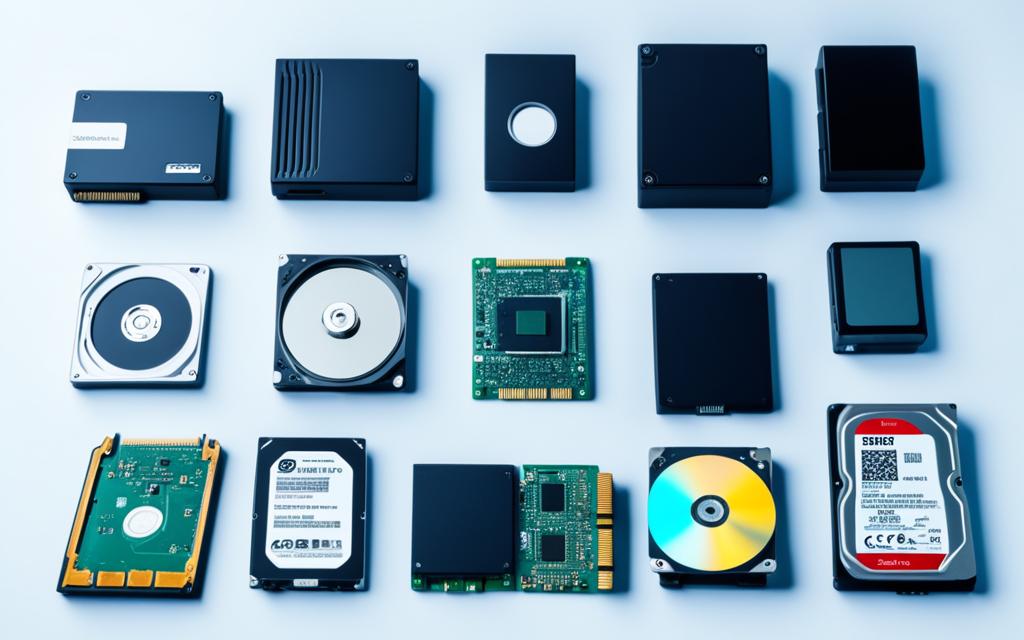Table of Contents
Getting to know computer data storage devices is key for tech lovers and experts alike. Let’s dive into the world of data storage abbreviations. These shortcuts are not just jargon but keys to smoother conversations and smarter decisions in tech. For example, abbreviations like HDD and SSD connect to specific storage types. They show how crucial they are in today’s tech talk1. What’s more, as storage tech evolves, new abbreviations pop up. This means we must keep up to stay sharp in the digital age2
Key Takeaways
- Familiarisation with essential data storage abbreviations aids in clearer communication.
- Recognising computer data storage devices helps streamline operations in various tech environments.
- Statistical data indicates how often these abbreviations appear, reflecting current trends in technology.
- Awareness of new tech abbreviations can enhance one’s adaptability in a fast-changing tech landscape.
- Understanding these terms provides a strong foundation for navigating modern data management practices.
Introduction to Computer Data Storage
Computer data storage is about saving digital info in different ways. It splits into two types: primary storage like RAM, and secondary storage. This includes Hard Disk Drives (HDDs) and Solid State Drives (SSDs). Understanding data storage overview is key. It helps us know how data is organised and accessed.
With more digital data every day, having the right storage is a must. This is true for both one person and big companies. Learning the digital storage basics is vital in our high-tech world.
Knowing the common abbreviations in data storage helps in talking about tech. You can learn more about these by visiting basic computer terms. It’s important whether for personal or professional use. The value of good data storage is huge3.
Understanding Computer Data Storage Devices Abbr
In the world of tech, data storage device abbreviations are key. They make complex terms simple, helping people understand tech talk better. Knowing these abbreviations helps in discussions about data storage.
Definition and Importance of Abbreviations
It’s crucial to know what data storage abbreviations mean. These essential abbreviations help people talk about tech without confusion. For example, HDD means Hard Disk Drive, and SSD stands for Solid State Drive. This knowledge helps people make smart tech choices and understand devices better.
Commonly Used Terms in Data Storage
There are some abbreviations you’ll hear a lot in data storage. Here’s a list of them:
| Abbreviation | Full Form | Description |
|---|---|---|
| HDD | Hard Disk Drive | Traditional magnetic storage device used for data storage. |
| SSD | Solid State Drive | Faster storage device that uses flash memory to store data. |
| RAID | Redundant Array of Independent Disks | Technology that combines multiple disk drives to improve data redundancy and performance. |
| NAS | Network Attached Storage | Storage device connected to a network that allows data access for multiple users. |
| API | Application Programming Interface | Set of protocols allowing different software applications to communicate with each other. |
Knowing these terms is crucial for managing data well. Whether it’s talking about gigabytes or RAID setups, understanding these terms is key.
Using simple tech language helps everyone understand data storage better. This ensures clear communication and better decisions in tech45.
Types of Computer Data Storage Devices
It’s key to know the different computer data storage devices out there. Each one has its own special features and jargon. This includes terms for HDDs, SSDs, and optical drives. Knowing these can help you pick the right storage for your needs.
Hard Disk Drives (HDD) and their Abbreviations
Hard Disk Drives are a top pick for mechanical storage. They use magnetic surfaces to store data. Terms such as RPM (Revolutions Per Minute) show how fast the disk spins. Most HDDs used to have a sector size of 512 bytes. But since 2010, many use 4K (4096 bytes)6. LBA (Logical Block Addressing) is common for fetching data, making sectors easier to manage6.
Solid State Drives (SSD) and Related Terms
Solid State Drives use flash storage to access data much faster than HDDs. Important SSD terminology includes IOPS (Input/Output Operations Per Second) and TBW (Terabytes Written). These terms show speed and how long the drive lasts. Knowing them helps pick a drive that meets your data needs.
Optical Drives and Their Terminology
Optical drives like CD-ROMs and DVDs use lasers to store data on discs. Key terms include CD-R (Compact Disc Recordable) and DVD-RW (Digital Versatile Disc ReWritable). CLV (Constant Linear Velocity) is how these devices read data. This jargon helps understand what these drives can do.
Getting to know the storage scene can lead to smarter choices about storing your data. For more on how to see your computer’s specs and what to think about when upgrading, see this guide.
| Device Type | Storage Method | Common Abbreviations | Key Features |
|---|---|---|---|
| Hard Disk Drive (HDD) | Magnetic | RPM, GB, LBA | Large capacity, slower access |
| Solid State Drive (SSD) | Flash | IOPS, TBW, GB | Fast access, durable |
| Optical Drive | Laser | CD-R, DVD-RW, CLV | Removable media, multimedia format |
Key Abbreviations You Should Know
In the world of computer data storage, knowing different abbreviations can improve your understanding and efficiency. Learning these terms helps you move through the changing tech landscape well.
Basic Data Storage Terms
Terms like SSD (Solid State Drive) and HDD (Hard Disk Australia) are basic data storage abbreviations. They’re key to knowing the types of storage you can find. Other terms like RAM (Random-Access Memory) and RAID (Redundant Array of Independent Disks) are important for handling data and boosting performance. About 38% of computer abbreviations are about storage, showing how important they are in tech language7.
Advanced Storage Technologies
New technologies bring terms like NVMe (Non-Volatile Memory Express) and AFA (All-Flash Array) to attention. They show the move towards advanced tech. Knowing these helps you understand innovations in storage that increase speed and capacity. It’s vital to know these advanced terms as we rely more on high-tech solutions.
File System Abbreviations
Acronyms for file systems like FAT (File Allocation Table) and NTFS (New Technology File System) are crucial. They help you manage storage and ensure systems work together. Terms related to networking such as DNS (Domain Name Server) and URL (Uniform Resource Locator) are also key. 15% of abbreviations deal with networking, which is essential in storing and finding data online7. For tips on screen capturing that helps with data management, check this guide.
Knowing these abbreviations not only boosts your tech knowledge. It also makes you more efficient in handling data storage tasks.
Data Transfer and Communication Protocols
It’s essential to know different data transfer protocols and communication interfaces. These are vital in tech integration and data management. Each protocol, like SATA, SCSI, and NVMe, plays a unique role. They enhance the performance and compatibility of devices.
Understanding SATA, SCSI, and NVMe Abbreviations
SATA stands for Serial ATA. It’s used for connecting hard disk drives and solid-state drives. This interface allows quick data transfer from storage to the motherboard, faster than old standards.
SCSI, or Small Computer Systems Interface, boosts data transfers across various devices. Its flexibility makes it a top choice for both businesses and personal use.
NVMe means Non-Volatile Memory Express. It boosts SSDs by using modern flash memory speeds. Recognizing these abbreviations helps us understand device compatibility and performance.
The Role of API in Data Storage
APIs link software applications with storage devices smoothly. They let developers manage storage easily, improving both speed and user experience with large data.
Through APIs, software can handle data in many ways, such as storing or retrieving it. Knowing about APIs helps developers better manage data and ensure applications work well with storage solutions.
| Protocol | Key Features | Use Cases |
|---|---|---|
| SATA | High compatibility, faster speeds for HDDs and SSDs | Consumer-grade storage solutions |
| SCSI | Supports multiple devices, high-speed data transfers | Servers, high-performance computing |
| NVMe | Optimised for SSDs, reduced latency | Gaming, data-intensive applications |
Data transfer protocols are key to storage performance. It’s crucial for tech professionals to know these standards. Acronyms related to protocols show their role in effective tech development89.
Importance of Recognising Data Management Abbreviations
Knowing the shorthand for data management boosts the effectiveness of data strategies. It lets professionals tackle data security and disaster management with assurance.
Backup and Recovery Terms Explained
Understanding data backup terms such as DR (Disaster Recovery) and RPO (Recovery Point Objective) is crucial. These terms are key to protecting important data. They also aid in creating strong data recovery plans. Such plans are vital for keeping operations running during crises.
The move towards cloud storage and remote databases makes learning these acronyms important. They help in shielding data in a fast-changing digital world.
Security-Related Abbreviations
Grasping data security terms and encryption acronyms like AES (Advanced Encryption Standard) and SSL (Secure Sockets Layer) is central to data safety. Knowing them enables people and groups to set up strong security walls. This is key in preventing data breaches. As cybersecurity evolves, keeping updated with these acronyms is a must for safeguarding data integrity.
| Abbreviation | Full Form | Importance |
|---|---|---|
| DR | Disaster Recovery | Essential for recovering from data loss due to disasters. |
| RPO | Recovery Point Objective | Defines maximum tolerable period of data loss. |
| AES | Advanced Encryption Standard | Standard for encryption to secure data. |
| SSL | Secure Sockets Layer | Protocol for ensuring data transmission security. |
Being aware of these terms not only helps in understanding but also in working together to keep data management strong. Building a solid vocabulary in this area is key to succeeding in the digital age101112.
Future Trends in Data Storage Abbreviations
The world of data storage is changing fast, with new technologies coming into play. We’re seeing new terms like QLC (Quad-Level Cell) and CXL (Compute Express Link). These advancements show the push for better efficiency and more space. For those interested in tech, it’s essential to keep up with these new abbreviations.
Emerging Technologies and New Abbreviations
The pace at which digital storage is evolving is impressive. Now, terms such as BaaS (Backup as a Service) and SaaS (Software as a Service) are becoming common. They mark a big change in how we access and manage data. Knowing what these abbreviations mean is key for anyone looking to improve their data storage strategies.
The Impact of Cloud Storage on Abbreviations
Cloud storage is changing the way services are provided. It’s also introducing a new set of terms into our vocabulary. With data volumes expected to jump significantly by 2025, understanding these terms is more important than ever. It’s vital for managing data efficiently and staying competitive.
Getting to know these new terms and trends will help businesses evolve. This knowledge is crucial in the rapidly changing world of digital storage13.
Conclusion
Knowing computer data storage device abbreviations is key in today’s complex tech world. By learning these abbreviations, you boost your tech knowledge. This helps you make smart choices about handling digital information and strategies.
The importance of understanding tech terms, like SSDs and HDDs, is growing. These formats significantly affect how well systems perform and how easily we can access data.
As technology evolves, so does the need to understand data storage abbreviations. This knowledge leads to efficient and confident use of technology, making sure we can make the most of it. The list of terms we’ve looked at is more than just information. It’s a boost towards tackling today’s tech challenges141516.
FAQ
What is the difference between HDD and SSD?
HDDs use magnetic platters to store data. SSDs use flash memory. This makes SSDs faster and more reliable.
Why are data storage abbreviations important?
Knowing data storage abbreviations helps in tech talk. It makes choosing storage solutions faster and easier.
What does RAID stand for and why is it used?
RAID means Redundant Array of Independent Disks. It boosts data safety and performance, enhancing protection and speed.
What is the significance of NVMe in data storage?
NVMe is short for Non-Volatile Memory Express. It speeds up data transfer in SSDs, key for fast applications.
How do file system abbreviations affect data management?
Abbreviations like NTFS and FAT guide file storage choices. They aid in organizing and finding data across systems.
What are some common data transfer protocols?
SATA connects drives, and SCSI enables quick communication. Both are essential for managing storage devices efficiently.
What are backup and recovery terms I should know?
Disaster Recovery (DR) and Recovery Point Objective (RPO) are crucial. They help in planning data recovery and reducing data loss risks.
What are some emerging technologies in data storage?
New techs like QLC increase efficiency and capacity. CXL brings better interconnect options, making connections faster.
How does cloud storage impact data storage abbreviations?
Cloud storage adds terms like BaaS and SaaS. These reflect new ways in managing and hosting data.
Source Links
- https://www.storagenewsletter.com/2012/05/28/storage-abbreviations/ – Storage Abbreviations
- https://en.wikipedia.org/wiki/List_of_computing_and_IT_abbreviations – List of computing and IT abbreviations
- https://kb.iu.edu/d/ackw – What are bits, bytes, and other units of measure for digital information?
- https://kb.wisc.edu/researchdata/page.php?id=101840 – Understanding Storage Units GB vs. GiB
- https://www.canto.com/blog/digital-storage-units/ – Digital storage units: What you should know
- https://superuser.com/questions/504/why-are-hard-drives-never-as-large-as-advertised – Why are hard drives never as large as advertised?
- https://byjus.com/govt-exams/computer-abbreviations/ – Computer Abbreviations & Acronyms – Download the List of Computer Abbreviations PDF Here
- https://www.pcisecuritystandards.org/glossary/ – Glossary
- https://www.dpsolutions.com/success-center/it-terminology-glossary – IT Terminology Glossary | Internet Technology Terms & Definitions
- https://gdcitsolutions.com/resources/it-acronyms-abbreviations/ – List of 2000+ IT Acronyms & Abbreviations
- https://www.richardtwatson.com/open/Reader/_book/data-structure-and-storage.html – Chapter 20 Data Structure and Storage | DataManagement.knit
- https://www.openclinica.com/electronic-data-capture/ – Electronic Data Capture
- https://www.dpconline.org/docs/dpc-technology-watch-publications/technology-watch-reports-1/2861-dpctw04-03/file – Microsoft Word – 4Feb05BLMass_storageDPC Report final[1].doc
- https://rockymtnruby.com/computer-acronyms/ – List of Common Computer Acronyms – Rocky MTN Ruby
- https://www.geeksforgeeks.org/computer-related-terms-abbreviations/ – Computer Related Terms Abbreviations (A To Z Full Forms)
- https://byjus.com/govt-exams/computer-storage-devices/ – What is a Computer Storage Device? | List of Important Storage Devices








